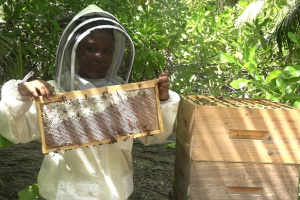Mangrove honey to be harvested at Seychelles’ Port Launay wetlands
[ad_1]
This is a new concept and was brought to the island nation by the sustainability coordinator at Constance Ephelia Resort, Hilary Albert. (Constance Ephelia Resort)
Seychelles will soon have its first harvest of mangrove honey, which is being produced by bees in the mangrove forest surrounding the Constance Ephelia Resort in Port Launay on the west of the main island of Mahe.
Mangrove honey is a unique and delicious type of honey produced in tropical climates. It is made from the nectar of mangrove trees found near the coastlines of South America, Africa, Asia, Australia and now in Seychelles.
In Seychelles, this is a new concept and was brought to the island nation by the sustainability coordinator at Constance Ephelia Resort, Hilary Albert, as part of her project in a training programme held by the hotel.
“It was through a development programme that, after some research, I learned about mangrove honey, and since at this hotel we have a large wetland area, which contains all seven types of mangrove, I felt it would be a good idea to try it out here,” Albert told SNA.
As part of her job, Albert regularly takes visitors on tour around the hotel, including in the mangrove area.
 |
| At the moment, only two bee colonies have been placed in the mangrove area. (Constance Ephelia Resort) Photo License: All Rights Reserved |
“I noticed that after one year on, I was still only showing clients the mangrove and with mangrove honey, I will now have something more to talk to them about,” she added.
This sort of honey is produced by mangrove trees that thrive in saltwater conditions, and the flavour of their honey is well-known. The coastal environment gives mangrove honey a slightly salty flavour. It is also a strong-flavoured, viscous, light-brown honey that has been compared to butterscotch or licorice.
“Aside from producing honey, the bees are also very effective pollinators and so they will also help this wetland to become more dense as well,” said Albert.
Some of the best mangrove honey in the world is produced in Mexico and Florida, which have coastal areas with extensive mangrove forests.
Beekeepers must set up their hives close to mangrove trees in order to generate honey. The bees will go to the mangroves and gather nectar from the flowers, bringing it back to the hive where it will be converted to honey.
Albert explained that she had never done any sort of beekeeping before taking on this project.
She had to learn through other experienced local beekeepers and sat for an online course to become a certified beekeeper as well.
 |
| Albert explained that she had never done any sort of beekeeping before taking on this project. (Constance Ephelia Resort) Photo License: All Rights Reserved |
At the moment, only two bee colonies have been placed in the mangrove area, but Albert says that more will be added in the future as she continues to monitor the progress of the current ones.
The Port Launay wetlands cover an area of 120.6 hectares on the western coast of Mahe, and have the highest-diversity mangrove areas in Seychelles, an archipelago in the western Indian Ocean.
It is also the biggest mangrove site in the Indian Ocean and the first site in Seychelles to be designated as a Wetland of International Importance under the Ramsar Convention.
“The hotel management has been very helpful towards my project, where they have financed my equipment and supported me throughout this journey,” added Albert, who only joined Constance Ephelia in 2021.
Clients staying at Constance Ephelia will be able to taste the mangrove honey in a few weeks’ time, with Albert saying that they will be giving the honey to clients as part of the souvenir of their stay at the hotel.
[ad_2]
Source link

